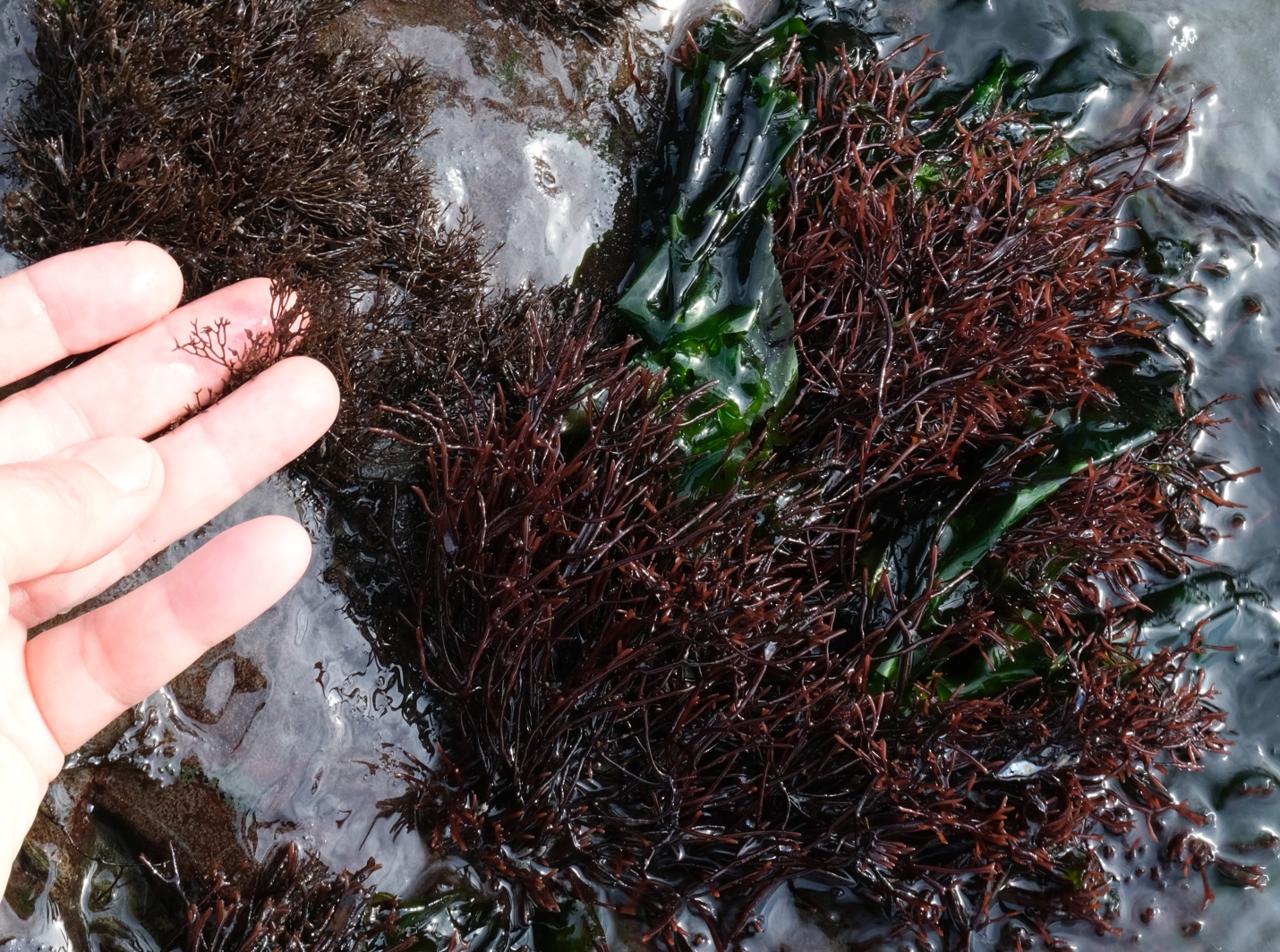
Fredericqia decewii
Cylindrical Forked Seaweed
7 June 2024
Fishboat Bay, Juan de Fuca Strait, Vancouver Island, B.C., Canada
Tide: -0.3 feet at 09:27am PDT (measured at Sheringham Point Tidal Station)
Weather: Clear skies, light variable winds (0-10 km/hour), sea smooth, very low swell, humidity 73%, 12 ˚C.
Moon: Waxing Crescent (1.9%, 1 day); Next Phase, First Quarter, 13 June 2024 at 10:18 pm PDT; Previous Phase, New Moon, 6 June 2024 at 5:37 am PDT.
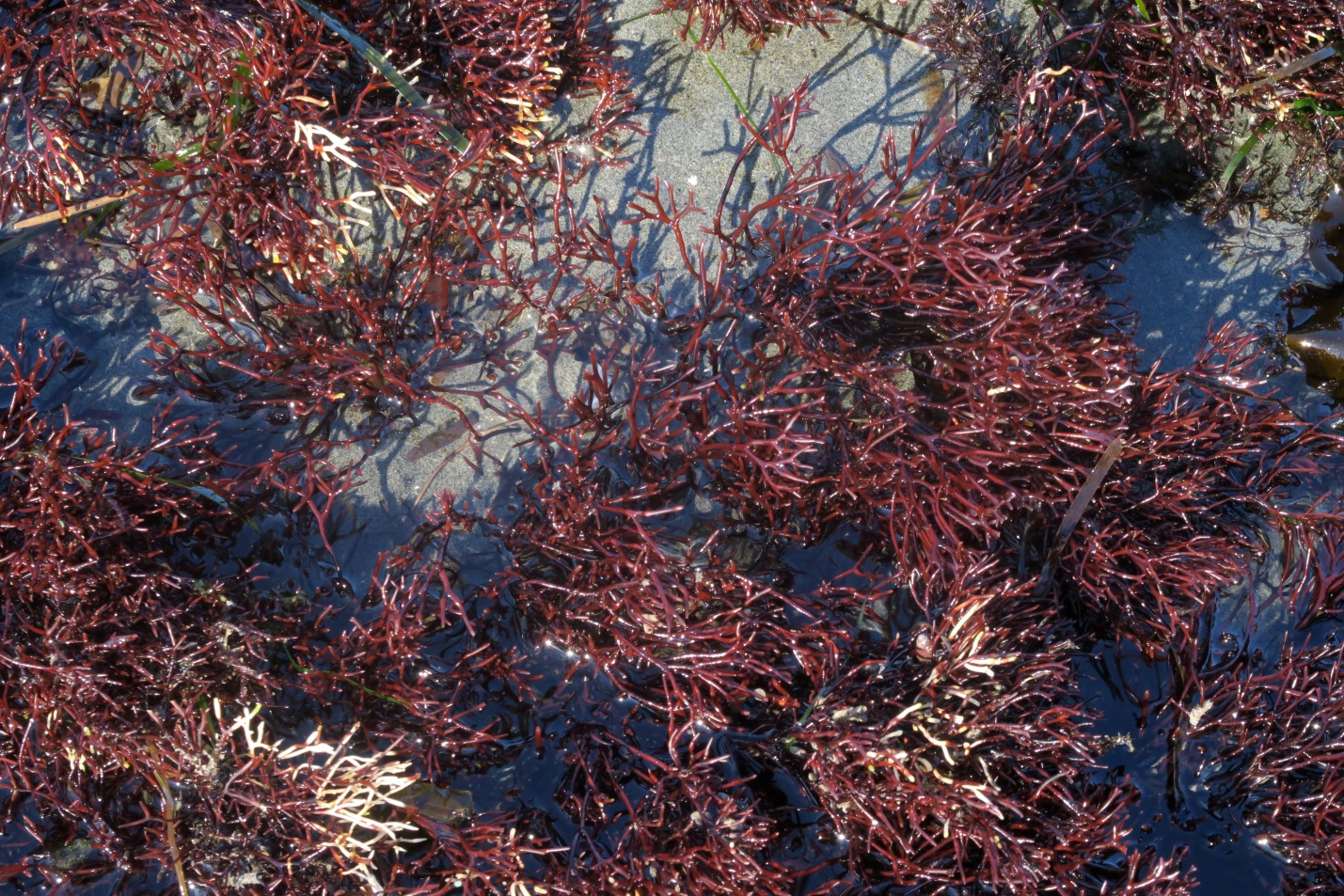
Figure 1: Fredericqia decewii is pictured here on the day of our Whispering. This was a very low tide, minus 0.3 feet to be precise, and seaweeds were exposed that on almost all other days would be safely and comfortably covered with at least some seawater. The substrate here is large bedrock boulders that are surrounded by abundant quantities of shifting sand and this is the preferred habitat of F. decewii. Notable in this photo is the dichotomous forking of the red, cylindrical branches, and also, in the photo just below, the rather impressive groupings such growth habits can produce. Fishboat Bay, Juan de Fuca Strait, BC, Canada. June 7, 2024. Photo ID 27694 ©Seaweedwhisperings.com
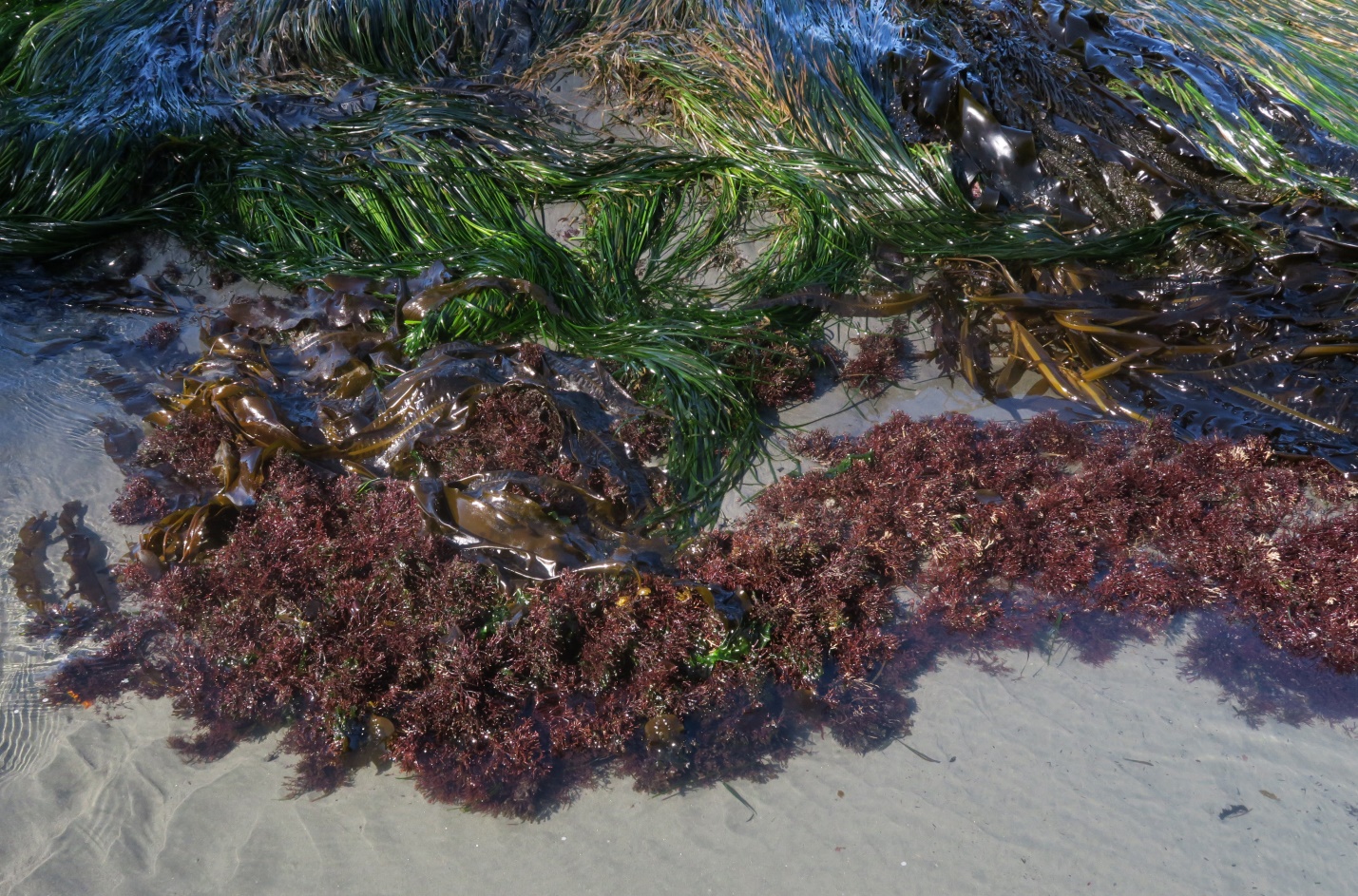
Figure 2: A colony of Fredericqia decewii is pictured in the foreground adjacent to the water-covered sand. Beneath this layer of sand there is a very large bedrock outcrop and it is to this that the Alaria marginata, seagrasses and Fredericqia decewii are anchored. In the early morning light the colors are vivid; of the ‘Forked Seaweeds’ Fredericqia decewii is the richest red in color, and all of them are members of the Rhodophyta – the ‘red’ macroalgae group. Fishboat Bay, Juan de Fuca Strait, BC, Canada. June 7, 2024. Photo ID 27695 ©Seaweedwhisperings.com
Person 1:
Person 2 has labeled this seaweed as “Freddy D”. I found that to be a very appropriate and amusing moniker.
Highly superficially social.
Likes the party, but doesn’t want to stand out.
Reminds me of a bunch of people on a party dance floor, all with arms waving, but totally into themselves and not really interacting with anyone else.
Big gang of people, more or less acting the same way.
Emerging from within only occasionally, then retreating to safety.
Self-indulgent but not really narcissistic. They’re not over the top, me, me, me, me.
Free form dancing but not showing off.

Figure 3: A small intertidal hedgehog rooting around some feather-boa holdfast ‘toes’, perhaps? No, this is algal not animal – and the tight cluster of Fredericqia decewii viewed here is anchored to a sand-immersed boulder adjacent to some Ahnfeltiopsis linearis, Egregia menziesii and abundant red crust seaweeds. May 6, 2023. Tonquin Beach, Templar Channel, Vancouver Island, BC, Canada. Photo ID 27696 ©Seaweedwhisperings.com
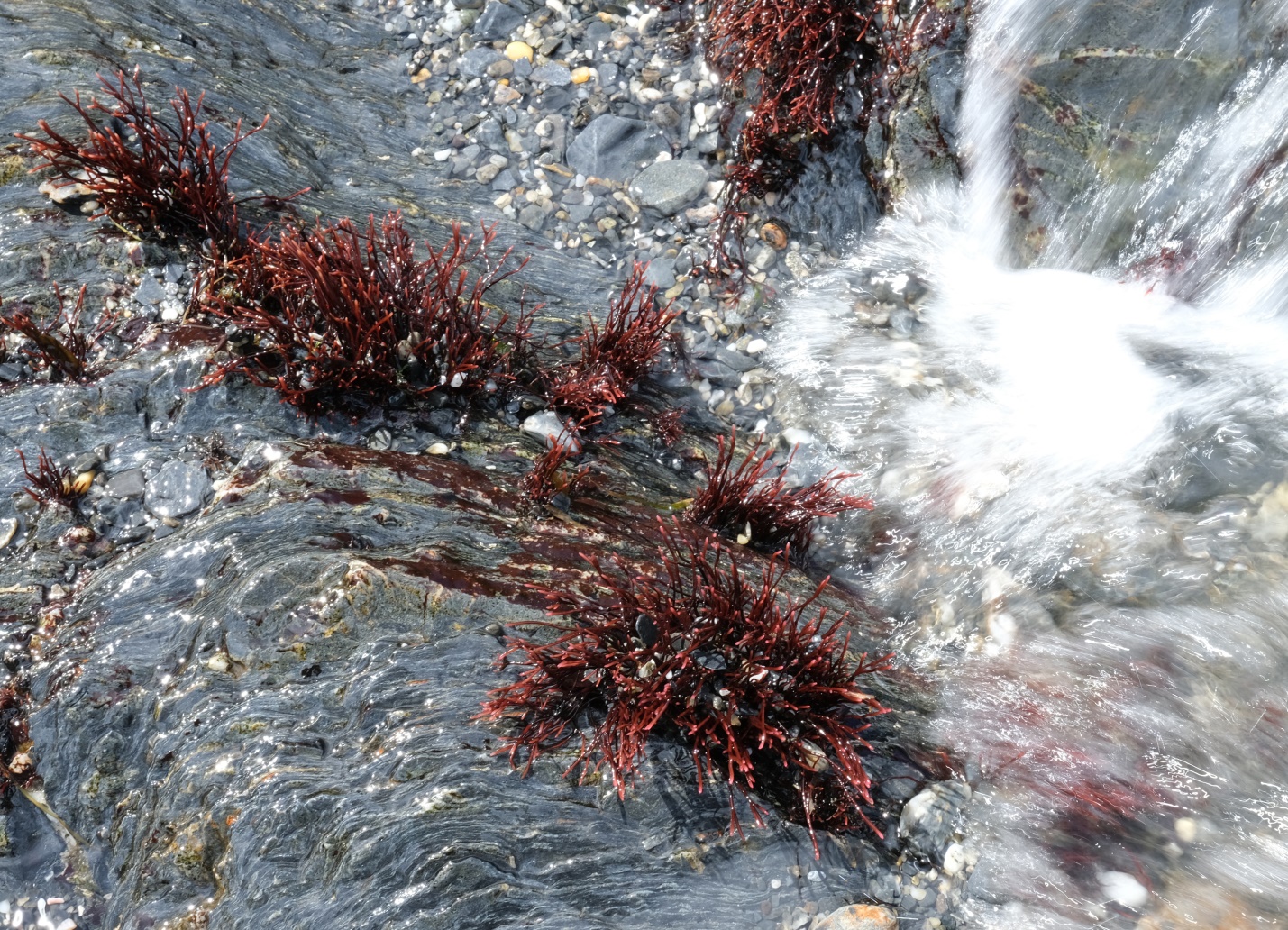
Figure 4: In this setting, Fredericqia decewii is living on bedrock surround by small gravel. It is holds within its many forked branches some of this substrate. The incoming surf routinely displaces more gravel – shifting some small pebbles and shell fragments in and also moving some on out again from the seaweed barrier. The tough and wiry branches of this seaweed can take all that in stride and flourish in such settings. Mill Bay, Port San Juan, BC, Canada. May 19, 2022. Photo ID 27697 ©Seaweedwhisperings.com
Person 2:
The sands have shifted once again here at Fishboat Bay. Medium sized cobbles that have been exposed in past visits are all hidden now by a smooth layer of sand. And in other areas, especially closer to the bedrock that rims the bay and protrudes at various points on the beach, sand has been pulled offshore and it has “exposed” many sand burial / sand abrasion tolerant seaweeds. Revealed are incredible numbers of Ahnfeltiopsis linearis individuals (Flat-tipped Forked Seaweed). It also has exposed, often just a bit lower on the tide line, countless Fredericqia decewii seaweeds.
Wow – how very much life exists where you can’t normally even see it! This is a thought to ponder...
Fredericqia decewii looks distinctly red in coloration compared to its well-known ‘forked’ associates, Ahnfeltiopsis linearis (chestnut brown and larger) and Ahnfeltia fastigiata (dark brown and smaller). It looks very red, today, especially with the new morning light angled low in the sky.
It is striking and stands out – in numbers and in redness! If it is visible at all, Fredericqia is notable. IF it is visible at all..., that is a big “if”, but there are times, such as today, when this is truly the case, and for this reason it was a good day to do a Whispering with “Freddy D” (with this scientific name I found myself soon desiring a shorter mouthful to reference, and Freddy D, felt like a good nickname. In fact more than a few of the clusters of this seaweed reminded me of bristly hedgehogs, and Freddy D feels like a good hedgehog name. And the spelling of Freddy needed to be with a ‘y’ not “Freddie” as the ‘y’ mimics the shape of the forked branches.)
And the red color, I quite quickly found myself asking – is this the red ‘blush’ of humiliation, shame or embarrassment? One that can color the face of a person when an error or secret has been exposed? Like being called out for failing to do a promised job on time? Or like the tint that flushes a teenager’s cheeks when someone else proclaims their love interest aloud?
Red.
Exposed.
Closely held personal feelings – shame or even guilt, suddenly made visible and taken note of by others.
Things not yet ready for “public” viewing.
Mortification, embarrassment, possibly at times there is even a deeper sense of shame and guilt. These are feelings Freddy D doesn’t have to deal with very often as they are normally not ‘visible’ – i.e. they are mainly either underwater at most tides or they are largely to entirely buried in sand! They are content with and can handle little bits of exposure, but not too much!
In fact, it seems if there is too much exposure in the wrong conditions then Freddy D goes from deep red to white.
Yikes! Do they suffer “shock”? It is like all the circulation drops from their ‘extremities’ (their multiple forked branch tips) and pools somewhere deeper in their core.
Or can it be like frost bite, another kind of exposure that harms the parts furthest from the core.
Can they recover from such shocks or damaging exposure?
Time might help...? Yes, given some time they can regroup, but it may take quite a while.
Sweetness could help – like a good “splash of sherry” in the cup of tea offered to console a person who’s just learned of the sudden death of a loved one? Yes, sweetness in the form of ‘calories’ would help fuel repair and regrowth, but also ‘sweetness’ in the form of quiet care and private support would be helpful, too.
It is interesting that I was first moved to look at these sudden “exposure” events for Fredericqia decewii, but other than in these extreme instances Freddy D is really physically quite strong and well adapted for life.
They have a wiry flexibility – they are not too brittle and certainly not too soft, either.
Their branches are cylindrical so there are no projections or fragile edges or fancy bits that the sand or small gravel of their environment would only quickly erode away.
In fact the anchored to rock embedded in sand or small gravel habitat that is preferred by Freddy D is very abrasive. This of course is most significant when the sand is at certain levels and the tide with its constant swells is at certain levels, too. If totally buried, sand abrasion is obviously not a factor; there is a rest from that but also no light for growth either. But if exposed to the open sea there is, with each rise and fall of the tides, perpetual abrasion occurring. You can see it on the rocks here, they are polished smooth. And for Fredericqia decewii, well, they handle this same effect very well indeed.
So, I think this seaweed has good composure for the routine discomforts and annoyances of life. It is the sudden things – the big events arriving unexpectedly that impact them. It hits them with a shock and a force that impacts deeply to their core. This is the important ‘stuff’, what they care deeply about and what motivates and centers them in their life. Ah, at times like this then Freddy D can suffer greatly. And how do they move through such sufferings? Their instinct can be to “bury it” but even if they do not do that, they move through their traumas very privately – outward signs are few.
This seaweed grows in a form that involves dichotomous branching. Branching in twos is how it likes to go and also those branches form quite open V’s. They are quite long and lean between the branching points, and when I looked closely I saw that rarely did they reach more than four dichotomous splits, often only three. What you notice when you see a cluster of this seaweed is the ultimate tips and these are, in most seasons, presented as small V’s. The outer limit looks quite tidy; all these V’s reaching upward and outward. But if you look deeper down, there is this surprising leanness. Physical leanness – yes, it looks as if at times Freddy D decides it needs to grow just a bit longer, longer, longer, and then maybe their branch tips will be above the sand/sediment level where they can reach some light and photosynthesize to nourish the whole. It doesn’t feel like time is a huge factor in this quest, as if they are in some kind of race, but the determination to grow taller towards the light feels to be very much at play.
In their character, too, it seems this quest for light can become important – it is a kind of realization that they arrive at quite naturally out of the traumas and shocks life has delivered. Again, this trait is not proclaimed in public – it is a very personal and private aspect.
Fredericqia decewii is quite small in overall size compared to other seaweeds. In fact it grows often where Alaria marginata, a brown kelp, also thrives. Freddy D reaches the maximum length of 20 centimeters, whereas A. marginata reaches lengths of 300 centimeters. Even Ahnfeltiopsis linearis, another forked red algae, doesn’t grow that much taller than Freddy D, but is much broader and has a far more substantial presence overall.
If you look at this seaweed beneath the V-tips, there is a sense that they are working very hard..., and that they have no time to investigate sidetracks and no interest in enhancing their beauty. They’ve got work to do and they’re getting it done as efficiently as they can.
There is a genuine appreciation for function over style.
The outer view of the whole, the “look” of Fredericqia decewii is one that is not what one would term “expressive”. It is a “look” for sure and quite recognizable, but it doesn’t reveal much about the feelings of the individual themselves. It isn’t that their look has a regular or rigid pattern, in fact it looks a little ‘hastily’ put together yet comprised all of the same basic components – the result is that it simply doesn’t reveal much. I thought of “reveal” and “unrevealed” and then later looked up synonyms for the latter. They were interesting and included: private, covert, undisclosed, off-the-record, concealed, hidden, underground, and buried. For Freddy D, perhaps it is the very fact that they routinely are themselves buried underground and concealed and hidden by sand that they end up with a countenance that is ‘unrevealing’ to!
The V’s at the tips give a semblance of order and balance that I think this seaweed does not wholly embody. It loves to feel balance and seeks that mode, but life can deliver blows quite often and this can knock Freddy D off balance. Shocks, surprises or powerful outside forces can put this seaweed into a “red alert” state – balance is lost and harm can ensue. They also can meet these powerful forces and endure them much of the time, however, the “red alert” state is one they prefer to not reside in for too long. Indeed, one must remember that they choose to live in settings where ‘shifting conditions’ are routine, if not predictable. Ah, maybe that is it; the unpredictability is their greatest challenge of all. It is the unpredictability which can undo the efforts of Freddy D and stop them short in their tracks.
Another observation about this seaweed is that it grows in groups. And the open V branching allows a kind of intermingling of individuals that forms a bit of a tangle of cylindrical red branches. These groups almost seem to form miniature barriers edging or surrounding their ‘home’ anchor boulders and rocks. As in medieval times when human weapons were fewer and natural impediments to invasion were employed, there is a sense here that Fredericqia decewii is working collectively to delineate and perhaps also protect a border or boundary. This is all rather beneficial for those living within the boundary and receiving the protection, but how is it for Freddy D out there to be facing any potential aggressors? It is quite clear that they do not want our sympathy, not at all. They are doing their ‘job’ and it is one that they are well-suited for; they have the will and the stamina to carry it out. They’ve gone “all in” and will do their best. It is a selfless and unquestioned act.
Since they don’t want sympathy, do they require any thanks? No, truly not. It is in the act of being a strong defensive protection that this energy type can find inner satisfaction. They don’t actually seek out danger, but they will meet it – face on, if they must. It is a kind of raw courage that they call upon, and then, at other times, even much of the time, they dip into a quieter position where they create an effective barrier that hides from view any details about that which they protect. In this role they mask whatever might otherwise be seen; their very presence is a distraction and an obstruction that is not impervious to everything, but is also really rather effective. They can in fact protect others from being ‘revealed’, too.
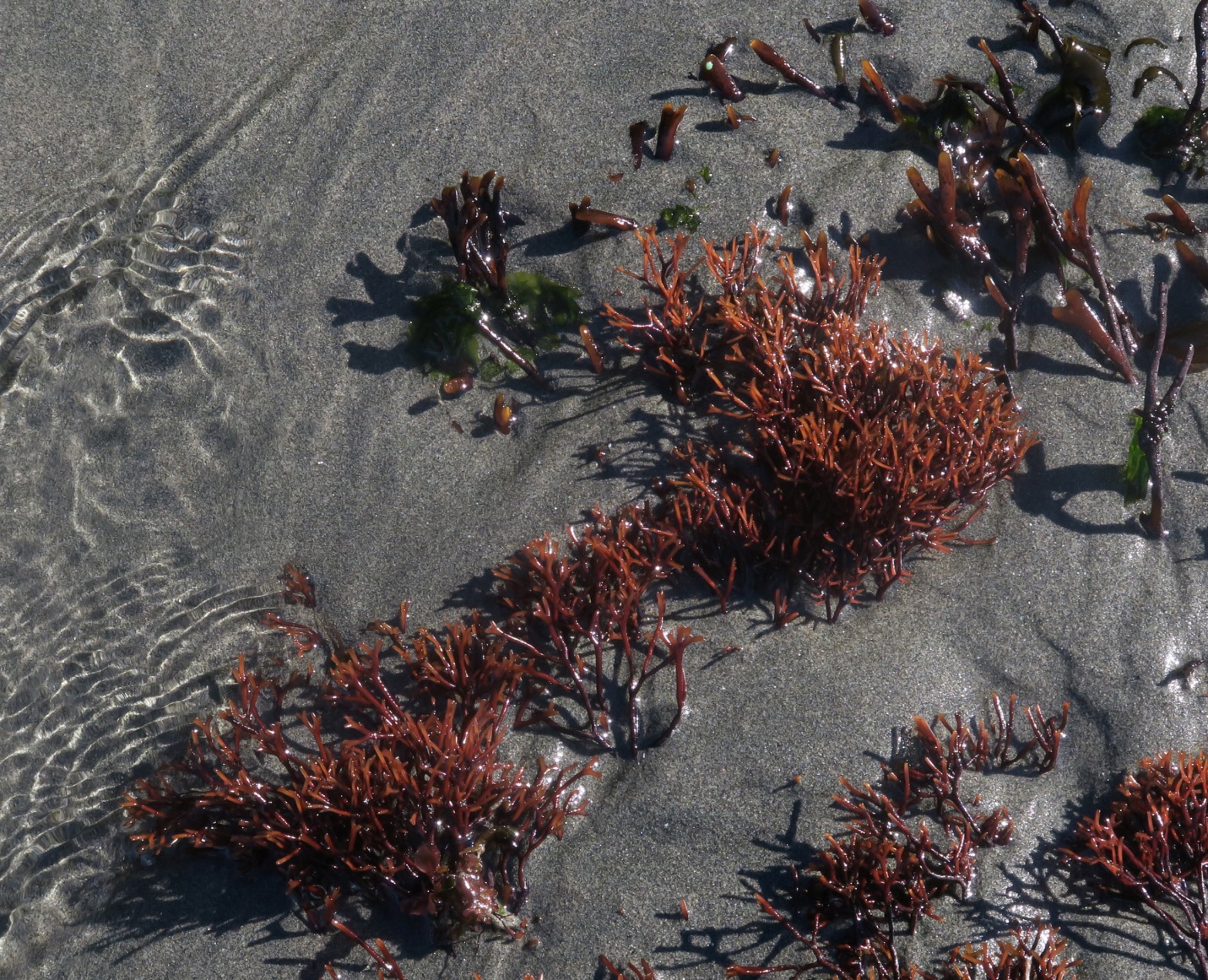
Figure 5: New growth shows at the branch tips as small V’s that are a lighter red-brown or pinkish color than the older parts of the thalli. The much larger and flattened V’s on at the top of the photo are Freddy D’s cousin, Ahnfeltiopsis linearis. Fishboat Bay, Juan de Fuca Strait, BC, Canada. June 7, 2024. Photo ID 27698 ©Seaweedwhisperings.com
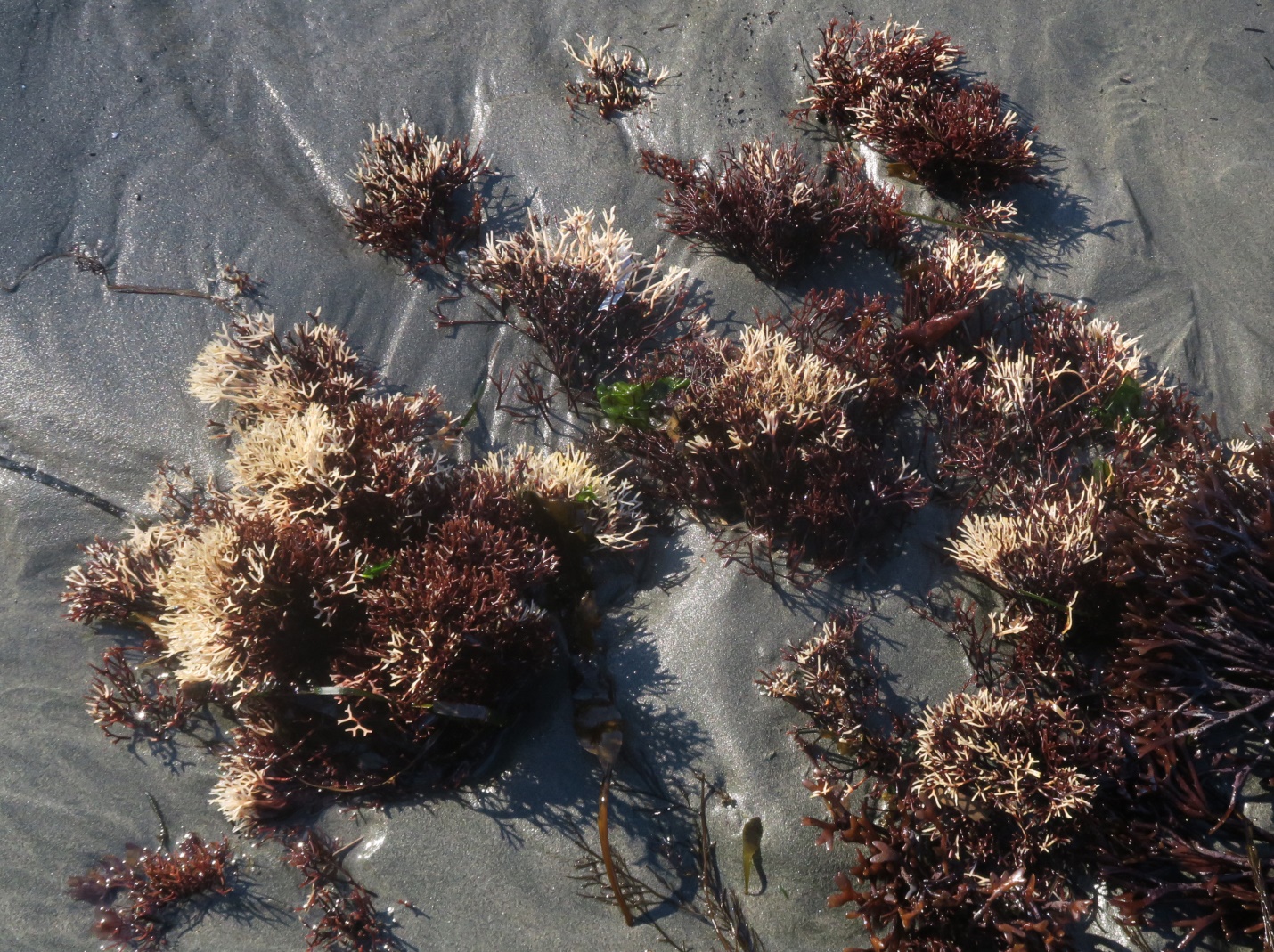
Figure 6: Bleached to a shocking white from the healthy deep red, these Fredericqia decewii individuals were exposed to harmful conditions. Is the newest growth, the ultimate forked branch tips more susceptible to harm? It seems that damage on some individuals here extends down the dichotomous branches by at least a few steps. This look is reminiscent of second degree frost bite, where the cold has penetrated the second dermal layer of fingers and toes. Fishboat Bay, Juan de Fuca Strait, BC, Canada. June 7, 2024. Photo ID 27699 ©Seaweedwhisperings.com
Discussion:
When contemplating this seaweed’s sand burial tolerance we noted – “How very much “life” exists where you can’t even see it”..., and later we saw that even if you do ‘see’ Freddy D any details are very self-contained, not truly revealed. There is a hidden quality to this energy that is strong.
A nickname really suits this seaweed because it captures part of the character but certainly not all of it. The name “Freddy D” provides a workable presentation label for this seaweed but it also is a kind of verbal ‘mask’ that covers, conceals, obscures or keeps private other traits and characteristics.
Both Persons doing this interaction described similar themes for this seaweed. And Person 2 wrote some of the themes from many different angles. We felt that this indicated a propensity for things being done ‘over and over’ again. This over and over again aspect is what was experienced in the overall character of the seaweed with individuals all looking and acting very similar to each other. Differences do exist, but they mainly are subtle and certainly not in the forefront.
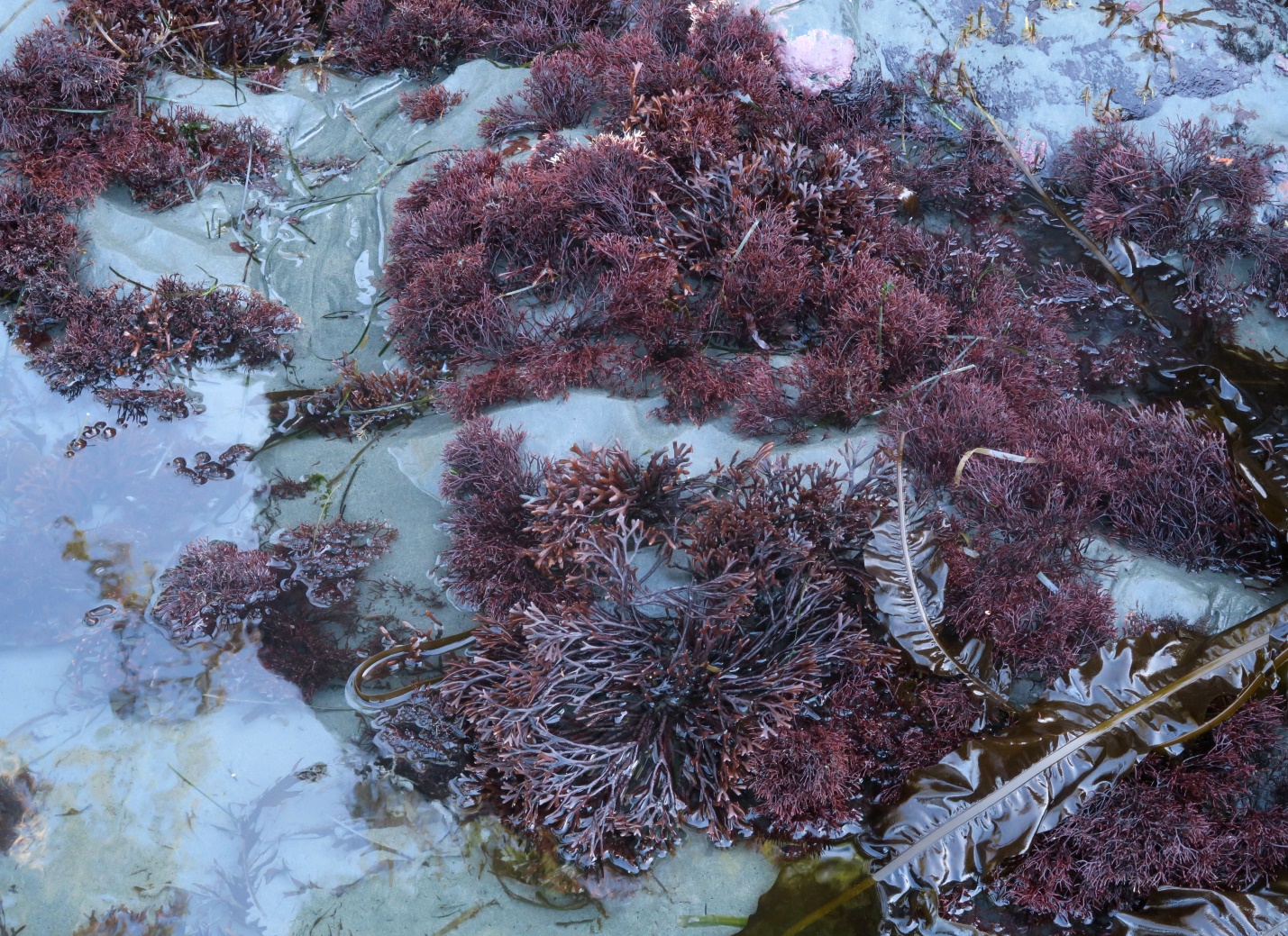
Figure 7: Tucked in a shady corner of the beach, these Ahnfeltiopsis linearis (largest forked seaweed) and numerous Fredericquia decewii individuals are thriving. There is almost no bleaching of these individuals, which may suggest that it is overexposure to direct sunlight that causes this type of damage. Two weeks later, we visited this same beach again and all of the above seaweeds had been covered with sand; if that were your only visit you would have no idea they were present and, in fact, abundant. Fishboat Bay, Juan de Fuca Strait, BC, Canada. June 7, 2024. Photo ID 27700 ©Seaweedwhisperings.com
Figure 8: In this photo the tiniest “Forked Seaweed” – Ahnfeltia fastigiata is held up for display against Person 2’s fingers. This gives an easy size comparison to the second Forked Seaweed, Fredericqia decewii, which is just to the right and occupying most of the frame. Fishboat Bay, Juan de Fuca Strait, BC, Canada. June 15, 2022. Photo ID 27701 ©Seaweedwhisperings.com
Biology & Natural History Information:
Description:
Dichotomously branched red algae that has cylindrical axes that are stiff and cartilaginous, making them abrasion resistant. Repeated forking of branches and stiff texture results in an overall fan-shaped morphology. Unless sediment is totally washed away, the holdfast is rarely seen; it consists of a creeping basal rhizome. Overall size reaches up to 20 cm long with branches measuring 0.5 – 1 mm in diameter.
Habitat:
Grows on rocks partially covered with sand or small gravel in the mid to lower intertidal regions of exposed shores. Tolerant to sand abrasion, this species is often found on wave-swept pocket beaches where sand is typically moved on-shore in spring and summer by gentle wave action and then off-shore once again by the stronger wave action of fall and winter.
Distribution:
Alaska, USA to Baja California, Mexico. The “holotype locality” of this species is Pachena Beach, Bamfield, Vancouver Island, British Columbia, Canada.
Remarks:
Grows in association with both the smaller Ahnfeltia fastigiata, Wiry Forked Seaweed, and larger Ahnfeltiopsis linearis, Flat-tipped Forked Seaweed.
Classification:
Phylum: Rhodophyta
Class: Florideophyceae
Order: Gigartinales
Family: Phyllophoraceae
Genus: Fredericqia
Species: Fredericqia decewii Maggs, L.Le Gall, Mineur, Provan & G.W.Saunders 2013.
Former name(s) and Synonyms: Ahnfeltiopsis pacifica P.C. Silva & DeCew 1979.
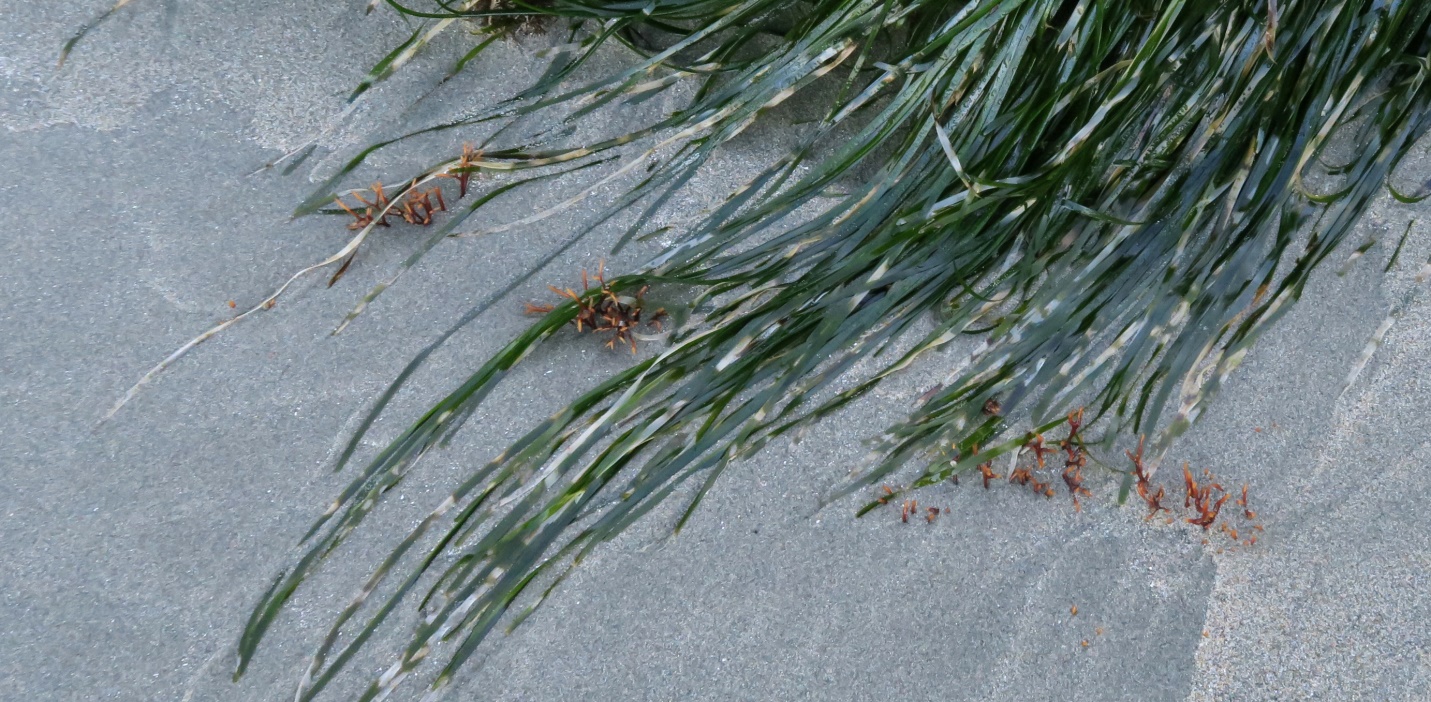
Figure 9: Strands of seagrass and the forked tips of Fredericqia decewii decorate the shifting sands at Tonquin Beach; buried under the sand lies the bulk of the Cylindrical Forked Seaweed thalli along with the boulder or rock outcroppings that they anchor to. This seaweed can look like it is “sprouting” out of the sand, but indeed it requires a far more permanent substrate for its holdfasts to grip. Tonquin Beach, Templar Channel, Vancouver Island, BC, Canada. May 7, 2024. Photo ID 27702 ©Seaweedwhisperings.com
![]()
